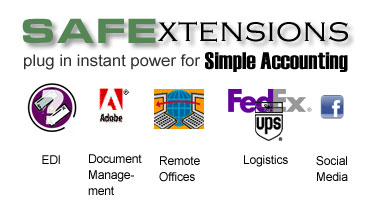When entering orders to be invoiced, you must enter a Sales Tax ID to indicate the various types of taxes to be applied to the sale. These are created and edited from the Files Main Menu.
Each ID can be used to apply an unlimited number of taxes for each sales invoice. Each tax for a Sales Tax ID is called a Sales Tax Entity for each Sales Tax ID. Each tax entity represents one of the taxes that is part of that ID. Some examples should illustrate what we mean:
If the state you are selling in collects only a single state sales tax, do the following:
- Create a single sales tax ID for all sales taxes collected. Then create a single entity with the same description, the sales tax percentage you need to collect, and the G/L account to assign the sales tax payable to.
- Create another Sales Tax ID for non-taxable sales. Enter Non Taxable Sales as the description. You do not need to create any entities for this ID, since no tax will be collected.
If you collect only one sales tax (again, for the state), but your state tax requires you to report separately for different types of non-taxable sales:
In this case, you can follow the same strategy, but you might also need to create a separate sales tax ID for each of these non-taxables as follows:
| GOVT | GOVERNMENT NON-TAXABLE SALES |
| NONPRO | NON-PROFIT NON-TAXABLE SALES |
| RESALE | NON-TAXABLE SALES TO RESELLERS |
In this way, you can run reports sorted and subtotalled by sales tax ID. This will give you totals for each type of non-taxable sale, as well as taxable sales.
If you collect multiple sales taxes in your state:
However, if you have the privilege of collecting more than one type of sales tax in your area, either for counties and/or different cities, then you need to create separate sales tax IDs for each combination of sales taxes you collect. This means that you will need to create multiple entities for each taxable ID.
For example, in some counties you might have a city sales tax, county sales tax and a state sales tax. Therefore you may be required to track and file separate sales tax reports for:
- Each county you sell in
- Each city you sell in
- Your state
For example, let us say you sell in Detroit, Michigan:
- Create a Sales Tax ID ‘DETROIT’.
- Then create three entities for this ID with the following descriptions, percentages and G/L accounts:
ENTITY DESCRIPTION % G/L ACCOUNT ‘STATE OF MICHIGAN’ 4.6 2200 ‘WAYNE COUNTY’ 2.0 2200 ‘CITY OF DETROIT’ 1.0 2200
You can use the same G/L Sales Tax Payable account if you dont need to track each payable individually on your financial statements.
Of course if you operate in Detroit, you most likely sell into lovely Livonia, Michigan; also in Wayne County. So now create another sales tax record ‘LIVONIA’
| ENTITY DESCRIPTION | % | G/L ACCOUNT |
| ‘STATE OF MICHIGAN’ | 4.6 | 2200 |
| ‘WAYNE COUNTY’ | 2.0 | 2200 |
| ‘CITY OF LIVONIA’ | 1.0 | 2200 |
Finally, you also sell in Southfield, Michigan in Oakland County. Oakland County is different: they collect no County Tax, even though Southfield collects a City Tax. So create another sales tax record ‘SOUTHFIE’
| ENTITY DESCRIPTION | % | G/L ACCOUNT |
| ‘STATE OF MICHIGAN’ | 4.6 | 2200 |
| ‘CITY OF SOUTHFIELD’ | 1.0 | 2200 |
One final thing: We have some non-profits in Detroit (Wayne State University) and these are non-taxable. So create another sales tax record for non-taxable sales in Detroit, Michigan with the ID ‘DET_TE’ (as in ‘Detroit_Tax Exempt). Even though no tax will be collected, you should still create a Sales Tax Entity with a zero percentage. In this way, you will be able to track all non-taxable revenue assigned to the City of Detroit.
OK. So we have now entered four sales tax IDs. And we have set up five sales tax entities:
| STATE OF MICHIGAN |
| WAYNE COUNTY |
| CITY OF DETROIT |
| CITY OF LIVONIA |
| CITY OF SOUTHFIELD |
You would then continue creating new Sales Tax IDs to include all the combinations of entities you sell into, plus records for the various non-taxable types of sales you wish to track.
THE SALES TAX ENTITY DETAIL REPORT
At any time, you can print a Sales Tax Entity Detail Report that will automatically group all sales by entity, regardless of their sales tax ID. This would for example, let you see all sales and taxes due in WAYNE COUNTY, regardless of Sales Tax ID. So long as `WAYNE COUNTY’ is one of the entities in a sales tax ID, all invoices assigned to any ID containing the WAYNE COUNTY entity will appear on the report. This lets you easily determine totals of sales and taxes collected for an unlimited number of sales tax entities, regardless of how many separate city, county and state taxes you are required to track. Using the Query Window, you can print this report for any range of dates for either a cash or accrual system.



